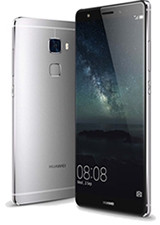
With the exception of some visible antenna lines, the whole outer casing of the Mate S is manufactured from metal. As a result, it has a nice feel in the hand and looks like it could take a punch. It doesn't bend or make a cracking sound, either, which is typically an annoying trait of cheap, low-end devices. Of course, the big plus of metal versus glass, featured on Samsung's S6 and Sony's Z5 line-up, is that it doesn't break when dropped. In general, it seems Huawei has copied some of the design from HTC's One series phones, which isn't a bad thing per se. The use of black edges around the screen, making it look like the bezels are extremely thin, is clearly an idea borrowed from HTC.
The Mate S's display is covered with fourth-generation Gorilla Glass to make it as scratch-resistant as possible. Huawei also used screen technology called 2.5D glass. In a nutshell, this is a display design where the glass sits on top of the rest of the body instead of being secured behind a slightly raised bezel. Like with Apple iPhone 6-series. Not only does this look cool, it also makes for comfortable swiping.

Although some other online reviews claim the Mate S is water or splash resistant due to a new kind of applied nanocoating, it just isn't. That's why I decided not to test the limits of my borrowed press-sample that needed to be returned to Huawei in fully working order.
Like with all previous Huawei smartphones, the company placed its own skin over the Android operating system. Their EMUI 3.1 software covers practically every aspect of the phone and is a drastic change from stock Android. Anyone looking for Android the way Google meant it to be, should stay clear of this phone.
Fingerprint reader: fast and accurate
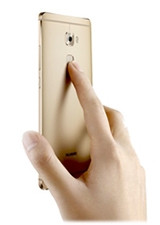
Like the Huawei Ascend Mate 7, the Mate S also houses a fingerprint reader, which works amazingly well and scans your finger from just about every angle. It can definitely match those on the latest Samsung and Apple devices. Its location, however, is debatable since you're always forced to pick the phone up to use it. On the other hand, you don't need to press the sensor like with Samsung or Apple devices. Just place your finger on the sensor and you've got access within a second.
The same fingerprint scanner also doubles as a mini trackpad. It allows for horizontal and vertical swiping through your photo library and notifications. Although, this feature works ok, I'm not convinced every business user will keep using it, since doing the same via the touchscreen is way more comfortable and efficient.
Hardware: unable to keep up
Huawei has been developing its own chips for a while now, so it won't come as a surprise that their new phone runs on a home-grown HiSilicon (Kirin 935) system-on-a-chip. This 28nm octa core chip uses four cores running at max 2.2GHz, while the remaining ones clock up to 1.5GHz.
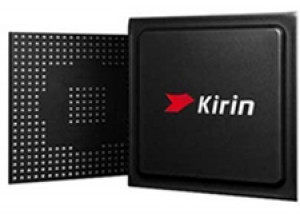
Huawei's choice for a SOC that was manufactured using a 28nm process is surprising - that was state-of-the-art a few years back. Competitors like Samsung and Apple are already producing chips using a 14nm process, which are faster and more energy efficient.
The Mate S only uses the 2.2GHz cores when the extra horsepower is needed, but their minimal operating frequency remains at 1GHz, making them inherently energy inefficient. Tasks that don't require that much processing power will be handled by the other cores, which mostly operate at much lower speeds than the 1.5GHz they are maxed out at.
For all graphics, the Mate S relies on an ARM Mali T628MP4 GPU, just like with the much cheaper Huawei P8 phone. It wasn't the best GPU then and surely isn't now in the considerably more expensive Mate S.
To somewhat compensate for the mid-range processing hardware, the Mate S houses 3GB of very fast (1600MHz DDR3) RAM. Not bad at all, but some competing flagship phones use even newer DDR4 memory modules. So again, no state-of-the-art hardware inside the Mate S.
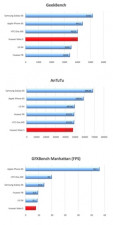
On the other hand, the Mate S supports the latest, even faster 4G+ protocol and allows for two SIMs. You can, however, choose to use the second SIM port as a storage expansion by fitting it with a micro SD-card. Talking about storage, the Mate S comes with 32GB of which 24GB is available for user content. Good to see Huawei chose to equip their entry-level model with this amount of GBs, compared to the meagre 16GB in the Apple iPhone.
I also found out that the Mate S doesn't support the latest 802.11ac WiFi standard, and can't connect to 5GHz networks. A strange decision on Huawei's part and simply unacceptable for an expensive smartphone nowadays. It doesn't support the latest Bluetooth 4.1 standard, either, only the 4.0 version which was launched a few years ago.
According to Geekbench, AnTuTu and GFXBench, the device has serious trouble keeping up with other high-end phones and even its predecessor. That doesn't mean it's slow. The Mate S packs more than enough power for demanding business users and even lunch-break gamers. However, it pales in comparison to its direct competition. Conclusion: at launch, the Mate S already falls behind, making the device far from future proof.
Screen: under pressure
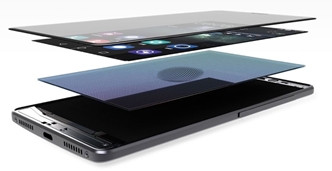
Huawei decided to put a Samsung produced amoled-screen in their Mate S, which is a first for this particular brand. The device houses a 5.5-inch pressure sensitive display able to show off a resolution of 1920 x 1080, resulting in a 400ppi pixel density. Despite the screen using amoled technology, it's not the latest generation. When directly compared to Samsung's Galaxy S6 screen with a maximum brightness level of 645 cd/m^2, I measured lower values of 400 cd/m^2 on the Mate S. Screen content still reads comfortably on a sunny day though, but just not as easy as on the Samsung S6 and iPhone 6S (560 cd/m).
Apart from the brightness not being on par with its price tag, other screen properties like contrast, viewing angles, colour reproduction and sharpness are more than adequate for most business users and photo enthusiasts.
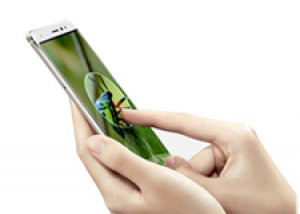
Huawei's new pressure sensitive touch technology is comparable to Apple's 3D Touch, facilitating new menu items and options based on the amount of screen pressure, like zooming in or previewing photos. Just like with Apple's implementation, this can be useful but takes some time getting used to.
Just like all its competitors, Huawei is also desperately seeking for that one killer feature to differentiate its product from all the others. In its wisdom, it chose something named "Knuckle Touch 2.0". This uses the built-in motion/pressure sensor combined with the microphone to detect that you are using knuckles and adjusts the menu or navigation item accordingly.
It only really works when you're holding the phone in your hand, so the motion sensor can actually detect the difference between a fingertip and knuckle. When the device is on a desk, the knuckle-function seldom works. In the end, using your knuckles to operate the phone isn't very comfortable or intuitive, making the whole Knuckle Touch more of a gimmick than an actual handy feature.
Battery life: easy to drain
The Mate S houses a battery with a significantly lower (2700mAh) capacity than the one inside the Mate 7 (4100mAh). Unfortunately, that doesn't come without consequences. According to my battery draining browser test, it shuts down after just five hours and 30 minutes. In real-life, that means the Mate S will be powerless after seven and a half hours, just before the end of a regular working day. To put things into perspective, the Mate 7 lasted 11 hours in the same test. Anyone planning to intensively use the Mate S for navigation or frequent communication will discover it to be empty long before the day ends.
The Mate S is no match for the Samsung Galaxy S6 and Apple iPhone 6S. It does, however, rank just as bad as the HTC One M9, LG G4 and Huawei P8. Compared to the previous Huawei Mate, as well as the competition, and taking its high price point into consideration, battery life while browsing is downright disappointing.

The video test, which is less of a strain on the device's hardware, shows a more positive outcome. The Mate S will last up to nine hours and 45 minutes while continuously playing Full-HD video. This can be reduced back to its energy efficient amoled screen technology, making it possible to completely turn off individual pixels when displaying black. This saves a lot of energy, therefore extending battery life. Only the Samsung Galaxy S6 is able to beat the Mate S with 12 hours and 20 minutes.
Camera: not afraid of the dark
For its rear camera, the Mate S uses a IMX278 sensor manufactured by Sony, which is the exact same one used in the previous P8 phone. This sensor differentiates itself from the masses because each pixel uses four sub pixels, instead of three. In addition to red, green and blue there's also a white one. Ultimately, this should result in higher light sensitivity and better pictures in low-light situations. The rear camera also features a dual LED-flash, with each flash using a slightly different part of the spectrum. The sapphire coated rear-cam has a resolution of 13 MP, but is set to a marginally lower resolution so it can take 16:9 pictures. The lens has an aperture of f/2.0.
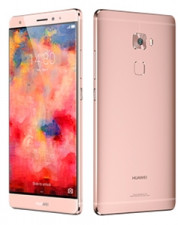
The front facing camera features a 1/3.2-inch Sony IMX179 sensor with an f/2.4 lens aperture, again the same as used in the P8 device.
After taking loads of pictures with both cameras, in various situations and scenarios, I concluded that both are very good. Even when there isn't that much light available the rear camera captures pretty impressive pictures full of detail. Many modern-day smartphones, even the Apple iPhone 6S, can't cope very well with darkness. It comes very close to one of the best smartphone cameras around, the one on the Samsung S6.
Bottom line: especially the rear camera on the Mate S is excellent and more than capable of capturing stunning pictures. The front camera is also good enough for a decent selfie or Skype conversation.
Final verdict
With the Mate S, Huawei is clearly aiming to compete with the big boys. Unfortunately, it can't. The internal hardware isn't cutting-edge, resulting in relatively mediocre performance. Battery life is also problematic, especially if you're planning to use the device frequently and intensively.
On the other hand, it does feature a solid, metal design and a good fingerprint reader. I was pleasantly surprised by the quality of the rear camera and the pressure-sensitive amoled screen. In the end, however, the Mate S just doesn't offer enough to fully justify its high price point.
Share